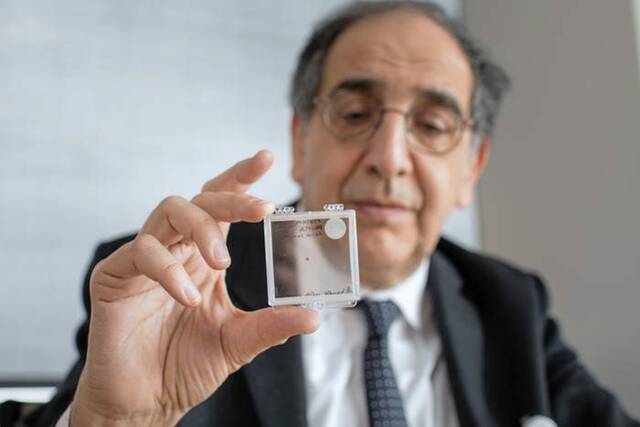Eye implant co-created by Pitt researcher helps the near-blind see again
A retinal implant the size of a strawberry seed co-created by a University of Pittsburgh researcher has helped partially restore vision for older people suffering from macular degeneration.
The study was conducted in Europe and co-led by Dr. José-Alain Sahel, chair of Pitt’s ophthalmology department and director of the UPMC Vision Institute.
The results, published last week in the New England Journal of Medicine, showed significant vision improvement after a year for 26 of 32 people who had the tiny device surgically implanted.
All participants were older than 60 and considered legally blind because of the disease, which affects part of the retina and erodes central vision, or people’s ability to clearly see things in front of them.
The implant mimics the light-sensitive cells destroyed by macular degeneration.
Sahel described the device, which measures just 2 millimeters each way, as a “miniaturized solar panel.”
It must be paired with specialized glasses. A small camera mounted on the frame captures images and sends them to a cell phone-sized processor in the user’s pocket. The information goes back up to the camera and is projected onto the implant.
From here, the brain’s normal vision processes take over and, in many cases, patients who are nearly blind regain some of their vision.
Before the implant, participants couldn’t see the first or second line of a vision chart. A year in, patients saw an average improvement of five lines, with one being able to see 12 more lines than before.
“They can read letters, they can read words and some of them can read a book, which is something we didn’t even really think could happen,” Sahel said.
At least one patient reported being able to navigate the subway again.
Disease afflicts millions
The system is called PRIMA, and has been in development for 20 years. Along with Sahel, Stanford University professor and study co-author Daniel Palanker has been a driving force behind this research.
Two past pilot studies showed promise, but “this is the first study of this size and this level of improvement that has ever been achieved in this field,” Sahel said.
Advanced macular degeneration affects more than 5 million people worldwide, according to the researchers. For those older than 80, it’s the leading cause of irreversible blindness.
The disease progressively blurs, darkens and distorts the center of the field of vision, while leaving peripheral vision intact.
In the late stages of macular degeneration, central vision goes completely dark. Existing treatments can only slow the disease’s advance.
Patients tend to just see zaps of light after surgery, Sahel explained, but through a training program, the brain learns to better process the implant’s signals. This usually takes a few weeks.
Even at its best, the bionic vision is limited. It appears in black and white and can be somewhat blurry.
Sahel and other researchers are working on a next-generation device with higher resolution.
PRIMA has the potential to restore vision in patients with other diseases, as long as they have a functional optical nerve. It cannot compensate for eye trauma, for instance.
Working with regulators
The device manufacturer, Science Corp., is working to obtain regulatory approval in the U.S. and Europe for use beyond clinical trials.
Science hopes to make PRIMA available in Europe by the end of 2026, according to spokeswoman Elizabeth McKenzie.
She did not give a target date in the U.S., but said the company is engaged in an approval process with the federal Food and Drug Administration.
Regulators will likely look at some of the negative effects reported in the study, mostly related to the surgery, rather than the device itself.
The procedure is done in most cases under general anesthesia, as opposed to just numbing the eye. To insert the chip, surgeons make a small incision into the retina — the back part of the eye used to detect light — and place the chip underneath it.
The most frequent side effects were pressure in the eyes, bleeding and small rips at the edges of the retina.
None were life-threatening, and nearly all resolved quickly.
Past studies already proved to Sahel the device was safe and effective. After these latest results, widespread use of PRIMA appears closer than ever.
“The goal was to show this is scalable,” he said.
Jack Troy is a TribLive reporter covering business and health care. A Pittsburgh native, he joined the Trib in January 2024 after graduating from the University of Pittsburgh. He can be reached at
Remove the ads from your TribLIVE reading experience but still support the journalists who create the content with TribLIVE Ad-Free.

